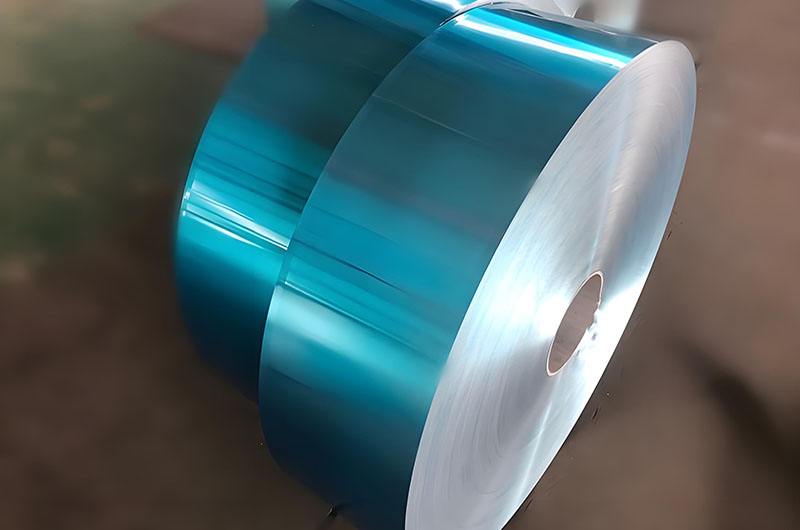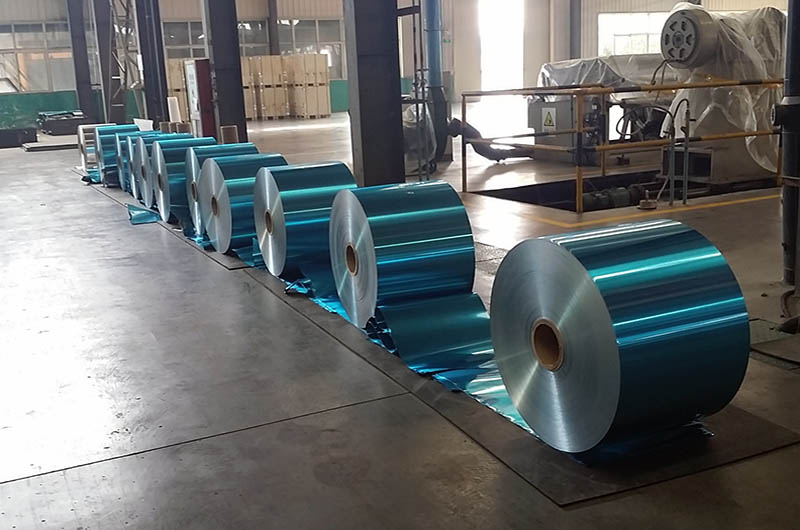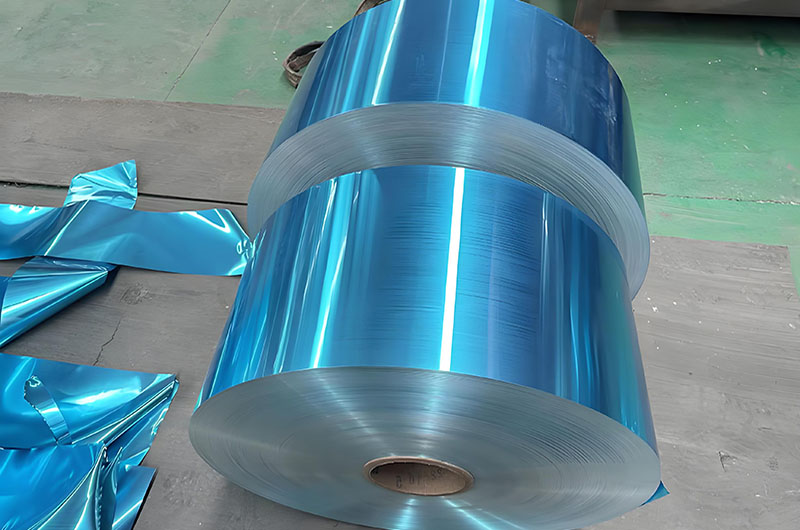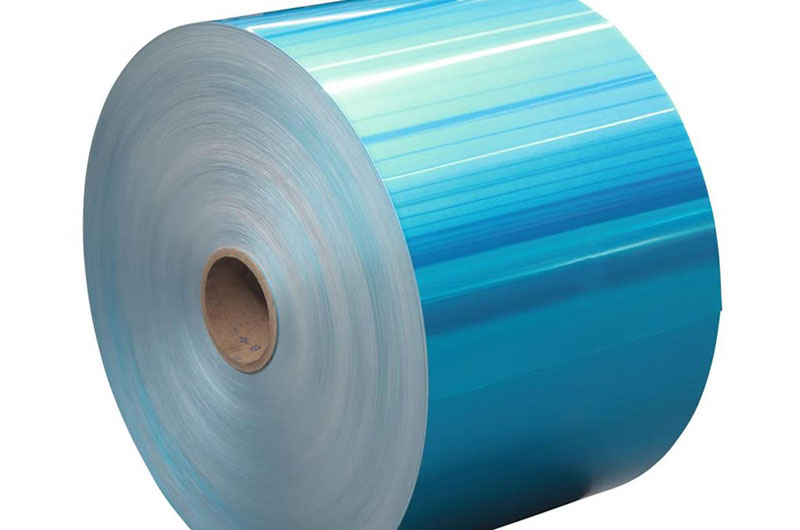Hydrophilic aluminum foil is a type of aluminum foil material that has undergone special surface treatment, with its core characteristic being the hydrophilic layer applied to its surface, significantly enhancing the material's affinity with water.
The hydrophilic layer reduces the surface tension of condensed water, causing the water to spread evenly rather than forming droplets, reducing the "water bridge" blockage between heat exchanger fins and improving heat transfer efficiency by 5%-15%.

Hydrophilic aluminum foil is a special type of aluminum foil that has been treated with a hydrophilic coating to alter its surface properties. This treatment transforms the normal waterproof nature of aluminum into a hydrophilic (water-attracting) surface, providing multiple functional advantages.
Hydrophilic aluminum foil is a thin and flexible aluminum sheet treated to exhibit hydrophilic ("water-absorbing") characteristics. Aluminum is chosen as the substrate due to its light weight, corrosion resistance, and thermal conductivity. The hydrophilic property is achieved through surface modification, making the foil attract and retain water rather than repel it.
Essentially, hydrophilic aluminum foil is a high-performance material designed to address the limitations of standard aluminum foil in moisture-prone applications. Its hydrophilic treatment enables it to effectively disperse condensed water, improve heat exchange efficiency, and provide enhanced durability, corrosion resistance, and mold resistance. These features make it an indispensable component in modern air conditioning, refrigeration systems, and other industrial applications where optimal heat management is crucial.
Aluminum Hydrophilic Foil Characteristics
- Enhanced Water Dispersion: The hydrophilic coating causes any condensed water to spread into a thin film instead of forming discrete droplets. This increases the effective heat exchange area, accelerating cooling and heating processes, while minimizing noise generated by water droplet impacts.
- Improved Heat Transfer: By eliminating water droplets that could obstruct airflow in heat exchangers, the aluminum foil enhances overall thermal conductivity. This can improve the cooling efficiency of air conditioning systems by about 5% or more.
- Corrosion and Mold Resistance: The coating not only aids water dispersion but also provides additional corrosion and mold protection. This is especially important in humid environments and refrigeration systems where moisture is prevalent.
- Mechanical and Chemical Stability: Hydrophilic aluminum foil has excellent formability and is resistant to stamping and molding wear. It also exhibits high tolerance to stamping oils, solvents, and even moderate heat, ensuring durability under various operational conditions.
| Characteristics | Description |
| Wettability | Low contact angle (<30°), promoting uniform water film formation, improving condensate discharge efficiency, and reducing water droplet retention. |
| Thermal Conductivity | Maintains the high thermal efficiency of aluminum and enhances heat transfer ability through uniform water distribution, improving the performance of air conditioning and heat dissipation equipment. |
| Corrosion Resistance | The coating typically includes corrosion-resistant additives to enhance durability, reduce oxidation and corrosion, and extend the service life, making it suitable for humid environments. |
| Antibacterial Potential | Some coatings include silver ions or other antimicrobial agents to inhibit microbial growth, reduce mold and bacterial proliferation, and improve air quality. |

Hydrophilic Aluminum Foil Specifications
| Alloy | 8011 8079 1100 |
| Width | 50-1500MM |
| Thickness | 0.01-0.2 |
| Colors | Blue, Golden, Black, Green, Rosy Red, etc. |
Aluminum Foil Hydrophilic Treatment Methods
- Surface Nanostructure: Etching or electrochemical processes create micro/nano-level roughness, increasing surface area and wettability.
- Chemical Coating: Application of hydrophilic polymers (e.g., polyethylene glycol), silica-based or inorganic compounds (e.g., titanium dioxide) to reduce the water contact angle.
- Anodizing: Formation of a porous oxide layer that can be further treated with hydrophilic agents.
Standards and Testing
- Contact Angle Measurement: Quantification of hydrophilicity (e.g., ASTM D7334).
- ASTM B895: Evaluation of the corrosion resistance of coated aluminum.
Popular Haomei Aluminum Hydrophilic Foil
8011 H16 Hydrophilic Aluminum Foil
8011 H16 hydrophilic aluminum foil is primarily used in refrigerant pipelines and the housings of outdoor units in air conditioning systems. This aluminum foil undergoes special treatment to impart excellent hydrophilic properties, effectively improving heat exchange efficiency.
Features:
- Superior Hydrophilic Performance: In air conditioning systems, 8011 H16 hydrophilic aluminum foil allows condensate to spread quickly, avoiding droplet accumulation and thereby enhancing the cooling effect of the system.
- Corrosion Resistance: With specialized hydrophilic treatment, this aluminum foil exhibits good corrosion resistance, maintaining stable performance in harsh environments.
- Durability: This foil maintains its performance even under high temperatures and humidity, making it suitable for long-term use in various air conditioning equipment.
1100/1200 O H11 Hydrophilic Aluminum Foil
1100/1200 O H11 hydrophilic aluminum foil is widely used in air conditioners, heat exchangers, evaporators, and other applications. Its excellent workability and corrosion resistance make it an ideal material for these devices.
Features:
- Excellent Workability: This aluminum foil is easy to process and shape, suitable for various manufacturing processes, and can meet the demands for complex shapes and sizes.
- Corrosion Resistance: The hydrophilic treatment provides superior corrosion resistance, effectively preventing corrosion caused by environmental factors.
- Stable Performance: It maintains stable performance over long-term use, ensuring the reliability and efficiency of the equipment.
Blue Hydrophilic Aluminum Foil
Blue hydrophilic aluminum foil features a special hydrophilic coating that provides excellent corrosion resistance, effectively preventing corrosion of air conditioning fins and heat exchangers during use.

Gold Hydrophilic Aluminum Foil
Gold hydrophilic aluminum foil is commonly used in high-end air conditioning equipment. Its gold coating not only adds aesthetic appeal but also offers outstanding corrosion resistance, significantly extending the lifespan of the equipment.
Gold hydrophilic aluminum foil maintains its appearance and performance over long-term use, making it suitable for applications requiring high durability.
Performance parameters of hydrophilic foil
| Coating thickness | 1.0~3.0μm (The average thickness of single side) |
| Hydrophilia | The initial hydrophilic angle≤5; Continuous hydrophilic angle≤25 |
| Adhesive force | Cupping Test (pressure deep 5mm): no flaking. Grid experiment (100/100): no delaminating. |
| Corrosion resistance | Salt fog test (72 Hours) R.N≥9.5 |
| Alkali resistance | With 20 degree centigrade, soak in the 20%NaOH with 3 Minutes, the sample coating layer totally no frothing. |
| Solvent resistance | Weight loss of Sample≤1% |
| Heat resistance | Under 200℃, keep for 5 minute, properties and the color remains the same; Under 300℃, keep for 5 minutes, coating layer just become light yellow. |
| Oil resistivity | In the volatile oil soaked for 24 hours, coating layer has no frothing |
Mechanical Properties of Aluminum Hydrophilic Foil
| Alloy | Temper | Indoor Mechanical Property | ||
| Tensile Strength | Elongation (%) | Cupping Test Value | ||
| 8011 | O | 80~100 | ≥20 | ≥6.0 |
| H22 | 100~135 | ≥16 | ≥5.5 | |
| H24 | 115~145 | ≥12 | ≥5.0 | |
| H26 | 125~160 | ≥8 | ≥4.0 | |
| H18 | ≥160 | ≥1 | - | |
Tolerances of Aluminum Hydrophilic Foi
| Thickness and thickness Tolerance(mm) | Width and Width Tolerance(mm) | ID(mm) | Max OD (mm) | ID Material |
| 0.095~0.50 (±0.005) | 50~1250 (±0.5) | ¢75, ¢150, ¢200 ¢300 ¢400 ¢500 | ¢≤1400 | Paper core, aluminium core |
Hydrophilic Foil Coating Performance
| No | Project Indicator | Technology Indicator | |
| 1 | Coating thickness | 1.0~3.0UM(The Average Thickness of Single Side) | |
| 2 | Hydrophilia | The Initial Hydrophilic Angle | The Initial Hydrophilic Angle ≤5 |
| 3 | Continuous Hydrophilic Angle | Continuous Hydrophilic Angle≤25 | |
| 4 | Adhesive Force | Cupping Test(pressure deep 5mm):No Flaking: Grid experiment(100/100):No Delaminating | |
| 5 | Corrosion Resistance | Salt fog test(72 Hours)R.N≥9.5 | |
| 6 | Alkali Resistance | With 20 degree centigrade , soak in the 20%NaOH with 3 Minutes, the sample coating layer totally no frothing | |
| 7 | Solvent Resistance | Weight loss of Sample≤1% | |
| 8 | Heat Resistance | Under 200 degrees Celsius, Keep for 5 minutes, Properties and the color remains the same;Under 300 degrees Celsius, Keep for 5 minutes, Coating layer just become light yellow. | |
| 9 | Oil Resistivity | In the volatile oil soaked for 24 hours, Coating layer has no frothing | |
| 10 | Coating Smell | No off-smell | |
| 11 | To the mold wear | Same as the ordinary aluminium foil | |
Comparison between Aluminum Hydrophilic Foil and Hydrophobic Foil
Hydrophobic foil repels water (e.g., for waterproofing), whereas hydrophilic foil controls moisture to improve thermal or hygienic performance.
| Comparison Item | Aluminum Hydrophilic Foil | Hydrophobic Aluminum Foil |
| Water Contact Angle | Low contact angle (<30°), water spreads evenly on the surface to form a uniform water film. | High contact angle, water droplets maintain a spherical shape and roll off quickly, not easily adhering. |
| Moisture Management | Promotes uniform flow of condensed water along the surface, reducing water droplet accumulation and improving heat exchange efficiency. | Repels water droplets, allowing them to be quickly expelled, preventing moisture infiltration and accumulation. |
| Application Areas | Widely used in air conditioning heat exchangers, condensers, evaporators, and other heat exchange equipment to enhance energy efficiency and improve heat exchange performance. | Mainly applied in outdoor equipment, electronic component protection, waterproof coatings, and environments requiring moisture and waterproofing. |
| Thermal Conductivity | Due to the uniform coverage of the water film, thermal conductivity is enhanced, improving the performance of refrigeration and heating systems. | Hydrophobic surfaces reduce water coverage, which may affect heat exchange performance but excels in waterproofing. |
| Corrosion Resistance | The hydrophilic coating typically includes corrosion-resistant components, reducing oxidation and corrosion, thus improving material durability. | Hydrophobic coatings can also enhance corrosion resistance, especially in humid or salt-spray environments, reducing material degradation. |
| Antibacterial Properties | Some hydrophilic coatings contain silver ions or other antimicrobial agents to inhibit mold and bacteria growth, improving air quality. | Hydrophobic surfaces reduce water retention, indirectly decreasing the likelihood of bacterial and mold growth, but do not have direct antibacterial properties. |
| Suitable Environments | Suitable for air conditioning systems, air purification devices, medical environments, etc., where enhanced heat exchange and hygienic performance are required. | Suitable for building waterproof layers, roof coatings, outdoor electronic equipment protection, and electronic device moisture-proofing in environments requiring waterproofing. |
Aluminum hydrophilic foil combines the inherent advantages of aluminum with advanced surface treatments to address moisture management challenges across industries ranging from HVAC to healthcare. Ongoing research focuses on improving coating durability, environmental sustainability, and cost-effectiveness.
Applications of Hydrophilic Aluminum Foil
Hydrophilic aluminum foil plays a crucial role in modern refrigeration technology, particularly in the heat exchange fins of various air conditioning systems. Its applications span across home air conditioners, refrigerators, and automotive air conditioners.
| Application Area | Description |
| Air Conditioning Equipment | Aluminum Hydrophilic Foil, as the core material of heat exchange fins, is widely used in home air conditioners, automobile air conditioners, refrigerators, and other refrigeration systems. Its low contact angle characteristic allows for the uniform distribution of condensate water, reducing water droplet adhesion and thus improving heat exchange efficiency. Furthermore, the foil’s anti-corrosion and anti-mold properties extend the lifespan of the equipment, while its noise reduction effect helps reduce operating noise and improve user experience. |
| Air Conditioning Units | Aluminum Hydrophilic Foil plays a key role in air conditioning units, whether for home or automobile use. Its excellent hydrophilicity promotes the rapid expulsion of condensate water, preventing water accumulation that could obstruct airflow. This characteristic not only improves cooling efficiency but also reduces the load on compressors, lowering overall energy consumption and making air conditioning systems more energy-efficient and environmentally friendly. |
| Refrigeration Equipment | Aluminum Hydrophilic Foil is widely used in evaporators and condenser coils of refrigeration equipment. With its excellent ability to form a water film, it effectively reduces frost accumulation and prevents ice layers from affecting heat exchange efficiency. This feature ensures that the equipment maintains consistent performance even in low-temperature environments, thereby improving refrigeration effects in food storage, pharmaceutical storage, and other fields. |
| Professional Industrial Uses | Aluminum Hydrophilic Foil is also of significant value in professional industrial applications. In addition to its use in cooling systems, it is also applied in environments where humidity management is critical, such as in the packaging of food, pharmaceuticals, and electronic components. Its uniform moisture distribution ability helps reduce humidity fluctuations, preventing product spoilage and ensuring quality stability during storage and transportation. |
| HVAC and Heat Exchangers | Aluminum Hydrophilic Foil plays an important role in HVAC systems and heat exchangers. Its unique ability to prevent water droplet formation helps reduce water accumulation on heat exchange surfaces, preventing heat exchange efficiency degradation caused by water film insulation effects. By improving the evaporative cooling process, it enhances the overall performance of air conditioning systems, ensuring that equipment operates efficiently even in high humidity environments. |
| Energy Systems | Aluminum Hydrophilic Foil can be used in energy systems to improve the efficiency of dehumidifiers and fuel cell components. Its excellent hydrophilicity helps efficiently expel moisture, reducing the impact of humidity on equipment performance and enhancing the operational stability of energy equipment. In fuel cell applications, it can optimize water management and improve the efficiency of electrochemical reactions, contributing to the development of new energy technologies. |
Air Conditioning Heat Exchange Fins
- Improved Cooling and Heating Efficiency: Hydrophilic aluminum foil, with its special hydrophilic coating, allows condensation to spread rapidly on the fins' surface, avoiding water droplet accumulation. This increases the heat exchange area and speeds up cooling and heating, thereby enhancing the overall efficiency of the air conditioning system.
- Enhanced Durability: Its excellent anti-corrosion and anti-mold properties effectively prevent damage from moisture and corrosion in the environment, thus extending the lifespan of the air conditioning equipment.
Refrigerator Condenser and Evaporator Heat Exchange Fins
- Increased Cooling Efficiency: The high hydrophilicity of the aluminum foil ensures that condensation spreads quickly, preventing the reduction in heat exchange efficiency caused by water droplet accumulation, thus enhancing the cooling effect of the refrigerator.
- Frost Prevention: Since condensation does not form into ice beads, hydrophilic aluminum foil effectively prevents frost formation on condensers and evaporators, maintaining stable operation of the equipment.
Automotive Air Conditioning
In automotive air conditioning systems, hydrophilic aluminum foil is primarily used in the heat exchangers of vehicle air conditioning units.
- Enhanced Cooling Effect: The rapid spreading of condensation with hydrophilic aluminum foil can improve the cooling efficiency of the vehicle's air conditioning system, making the interior environment more comfortable.
- Increased Durability: Its anti-corrosion properties ensure that automotive air conditioners maintain stable performance in various driving conditions, such as humid or salt-laden environments.
Hydrophilic aluminum foil is a high-performance material that, due to its superior hydrophilicity and anti-corrosion characteristics, has become an indispensable component in modern air conditioning and refrigeration equipment. Its application in home air conditioners, refrigerators, and automotive air conditioners not only enhances the heat exchange efficiency but also improves durability and reliability, providing users with more efficient and long-lasting cooling solutions.

Aluminum Hydrophilic Foil Performance Advantages
| Performance Advantage | Description |
| Enhanced Heat Efficiency | Aluminum Hydrophilic Foil has high thermal conductivity, allowing heat exchange fins to transfer heat more quickly, accelerating the cooling process and lowering the temperature of the medium. Additionally, its hydrophilic coating effectively reduces condensate retention, preventing thermal resistance caused by water droplets and improving heat exchange efficiency. Experimental data shows that, compared to regular aluminum foil, hydrophilic aluminum foil can improve heat exchange rates by 10%-15%. |
| Environmental Friendliness and Safety | Aluminum Hydrophilic Foil is made from non-toxic and harmless materials that comply with international environmental standards, ensuring safe use in various environments. Moreover, the special formula in its coating effectively inhibits the growth of bacteria and mold, reducing the risk of microbial contamination in air conditioning or refrigeration systems, thereby improving air quality and enhancing comfort and health. |
| Durability | Aluminum Hydrophilic Foil improves the corrosion resistance of aluminum foil through advanced surface treatment processes, enabling it to maintain stable performance in high humidity and condensation environments. This corrosion resistance effectively extends the lifespan of heat exchangers while reducing performance degradation due to scale buildup, thus lowering maintenance and replacement frequencies. |
| Extended Service Life | Aluminum Hydrophilic Foil has excellent anti-corrosion and anti-mold properties, protecting heat exchangers from moisture and corrosive gases. This not only reduces the maintenance needs of the equipment but also significantly extends the service life of heat exchangers, ensuring consistent heat exchange efficiency during long-term operation and lowering operating costs. |
| Noise Reduction | Aluminum Hydrophilic Foil, through its hydrophilic coating, prevents the aggregation of condensate water droplets and vibration, thereby avoiding noise issues caused by dripping or flowing water droplets. This feature is particularly important in air conditioning and refrigeration systems, where it effectively reduces operating noise, improving the quietness of the equipment and providing users with a more peaceful and comfortable environment. |
Aluminum Hydrophilic Foil vs. Untreated Foil
| Advantages | Description |
| Prevents Water Droplet Formation, Improves Heat Transfer in Cooling Systems | Aluminum Hydrophilic Foil uses a special hydrophilic coating that significantly reduces the contact angle of condensation water, causing the moisture to spread evenly into a water film rather than forming water droplets. This characteristic reduces thermal resistance on the heat exchanger fins, improving the contact efficiency between the air and the heat transfer surface, significantly enhancing the heat transfer performance of the cooling system. Compared to untreated aluminum foil, it provides higher heat exchange efficiency. |
| Reduces Issues Related to Condensation in Packaging | Aluminum Hydrophilic Foil performs excellently in packaging for food, pharmaceuticals, and electronics. Its superior hydrophilic properties prevent water droplets from forming inside the packaging, reducing the risk of moisture, spoilage, or short circuits caused by condensation. Compared to untreated aluminum foil, it offers better humidity control and product protection. |
| Extends Service Life in Humid Environments with Corrosion-Resistant Coating | Aluminum Hydrophilic Foil is treated with a corrosion-resistant coating, allowing it to maintain excellent performance in high-humidity environments without being easily affected by condensed water or corrosive substances in the air. Compared to untreated aluminum foil, it significantly extends the service life of heat exchangers, refrigeration equipment, and other applications, reducing maintenance costs and improving long-term reliability. |
Aluminum Hydrophilic Foil Manufacturing Process
- Base Foil Production: High-purity aluminum is rolled into thin sheets using continuous casting and rolling processes. Typically, two layers of foil are processed simultaneously, producing one shiny side (in contact with polishing rollers) and one dull side.
- Surface Treatment: The foil undergoes degreasing, cleaning, and drying to prepare its surface for coating. Then, a hydrophilic layer (usually made from specialized polymers or inorganic compounds like silica) is applied using techniques such as spraying, immersion, or electrochemical deposition.
- Curing and Finishing: After coating, the foil is cured or baked to fix the hydrophilic properties, followed by cutting and packaging according to the specifications of various applications.
Related Questions About Aluminum Hydrophilic Foil
Why is aluminum foil hydrophilic?
Aluminum foil itself does not have inherent hydrophilicity, but it can be treated to acquire this property.
- Surface Treatment: Aluminum foil is subjected to degreasing, cleaning, and acid etching to remove surface oil and oxidation, making it more receptive to subsequent coatings.
- Application of Hydrophilic Coating: A hydrophilic coating (usually organic or inorganic) is applied to the aluminum foil surface, giving it hydrophilic properties. This coating attracts water and encourages rapid spreading of moisture rather than forming droplets.
What is hydrophilic aluminum?
Hydrophilic aluminum refers to aluminum materials that have been specially treated with a hydrophilic coating.
Characteristics of Hydrophilic Aluminum:
- Hydrophilic Coating: The surface is coated with a layer that forms hydrogen bonds with water molecules, allowing water to easily contact and spread across the aluminum surface.
- Corrosion Resistance: Hydrophilic aluminum typically has excellent anti-corrosion properties, protecting against corrosion in moist environments.
- Improved Heat Exchange: When used in heat exchangers, hydrophilic aluminum can enhance heat exchange efficiency because condensation does not pool into droplets, increasing the heat exchange area.
Does aluminum foil react with water?
Under normal conditions, aluminum foil does not undergo significant chemical reactions with water. However, under certain specific conditions, the reaction can occur as follows:
- Under Normal Conditions: At room temperature and pressure, aluminum foil does not directly react with water. The surface of aluminum typically forms a thin layer of aluminum oxide, which protects it from further corrosion by water or oxygen in the air.
- In Strongly Alkaline or Acidic Environments: In strongly alkaline (e.g., sodium hydroxide solution) or strongly acidic environments, aluminum foil may react with water. For example, in an alkaline environment, aluminum reacts with water to produce hydrogen gas and aluminum hydroxide.
Hydrophilic-treated aluminum foil does not directly react with water but utilizes its improved surface characteristics to enhance heat exchange efficiency and corrosion resistance.
